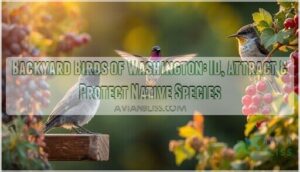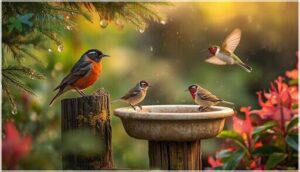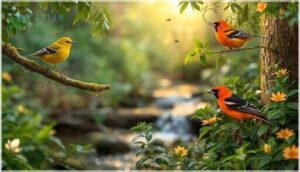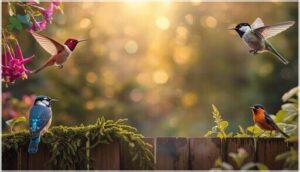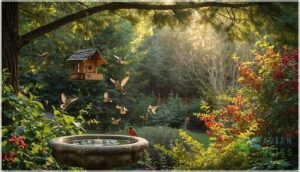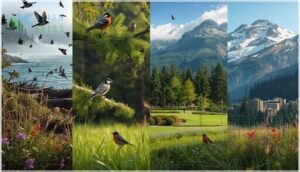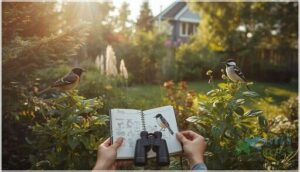This site is supported by our readers. We may earn a commission, at no cost to you, if you purchase through links.
A Dark-eyed Junco just landed at your feeder, and you’re not sure if it’s a winter visitor or a year-round resident. You spot a flash of orange and black in your Douglas fir—could that be a Townsend’s Warbler passing through?
Washington’s backyard birds shift with the seasons, bringing different species to your feeders and gardens throughout the year. Some, like the American Robin and Anna’s Hummingbird, stick around all twelve months. Others migrate in for summer breeding or winter shelter.
Learning which birds call your yard home—and when—helps you create spaces they actually need, from native plant clusters that fuel long migrations to clean feeders that support winter flocks.
Table Of Contents
- Key Takeaways
- Common Backyard Birds in Washington
- Identifying Backyard Birds in Washington
- Attracting Birds to Your Washington Yard
- Bird Habitats and Distribution in Washington
- Conservation and Citizen Science for Backyard Birds
- Frequently Asked Questions (FAQs)
- What are the most common backyard birds in Washington?
- What is Washington State’s state bird?
- What does a Bluebird look like in Washington State?
- How do I identify a bird in my backyard?
- What is the most common backyard bird?
- What is killing birds in my yard?
- What is the big brown bird in Washington state?
- What is the best time for birdwatching in Washington?
- How can I create a bird-friendly garden in Washington?
- Which birds in Washington prefer specific types of feeders?
- Conclusion
Key Takeaways
- Washington’s backyard bird community includes year-round residents like American Robins and Anna’s Hummingbirds alongside seasonal migrants, with Dark-eyed Juncos making up 21% of winter sightings and warblers peaking in late May through July.
- Native plants directly boost bird diversity by 12–28% over 2–5 years because they support 20–35% higher caterpillar abundance, which is critical food for nestlings during breeding season.
- Clean feeders every two weeks to cut disease transmission by up to 35%, and place them 3–4 meters from windows to prevent collisions that cause 25–40% of backyard bird fatalities.
- Joining citizen science programs like eBird or FeederWatch transforms casual bird watching into conservation data, with over 100 million annual observations powering distribution analyses across Washington state.
Common Backyard Birds in Washington
Washington’s backyard bird community shifts with the seasons, but a solid roster of species sticks around no matter the month. You’ll spot some faces at your feeder year-round, while others drop in only when conditions suit their breeding or wintering needs.
Here’s how the lineup changes across the calendar.
Year-Round Resident Species
Year-round residents bring life to your Washington yard every season. These native birds don’t migrate, so you’ll spot them through rain, snow, and sunshine. Supporting them means learning their habits and creating bird-friendly yards that work all year.
Understanding the birds’ behavior involves analyzing qualitative data to identify patterns and trends.
- American Robin – About 16 million strong, thriving in gardens and forests
- Bewick’s Wren – Roughly 1 million birds with distinctive white eyebrows
- House Finch – Over 12 million individuals in urban areas
- Anna’s Hummingbird – 700,000 year-round coastal residents
Summer Migrants and Visitors
While year-round residents hold steady, summer migrants and visitors bring seasonal energy to your Washington yard. Roughly 28% of backyard birds at some locations are seasonal migrants during summer months, with warblers peaking in late May to July.
These migrant birds favor mixed forests near water, where insects make up 60–85% of their diet during brood-rearing. Researchers use qualitative data analysis to study the behaviors and patterns of these bird species.
Winter Birds and Seasonal Variations
As summer migrants depart, winter migration brings new activity to your yard. Dark-eyed juncos make up 21% of winter backyard sightings, while red-breasted nuthatches increase feeder visits by 14% in January–February. These seasonal shifts reflect bird adaptation to cold weather.
Winter bird feeding strategies matter—seed blends with sunflower and nyjer attract 28% more species than suet alone, supporting diverse bird migration patterns across Washington.
Identifying Backyard Birds in Washington
You don’t need to be an expert to start identifying the birds in your Washington yard. Size, shape, color, and behavior give you everything you need to tell one species from another.
Here’s how to read the field marks that matter most.
Size, Shape, and Field Marks
When identifying backyard birds, you’ll notice size, shape, and field marks tell the story before color ever enters the picture. Start with these basics:
- Bird silhouettes reveal overall proportions—American Robins show oval bodies with long tails, while Black-capped Chickadees appear compact and round.
- Beak shapes indicate diet—stout bills signal seed-eaters like House Sparrows, slender bills mark insect hunters.
- Wing tips and tail feathers aid flight-pattern recognition—Northern Flickers display white rump patches during takeoff.
- Field marks like the Steller’s Jay’s squared tail or Mourning Dove’s pointed profile clinch backyard birding identification.
Color Patterns and Songs
Plumage variation unlocks instant bird identification—58% of Washington yard species display at least two distinct color morphs that catch your eye. Male Northern Cardinals flash vivid red in 99% of cases, while Song Sparrows show heavily streaked flanks in 3–5% of individuals.
Bird vocalization clinches the ID: House Finches trill at 3.5–5.0 kHz, and Black-capped Chickadees repeat their namesake call to rally flockmates.
Habitat and Behavioral Clues
Foraging behavior tells you what species you’re watching. Habitat preference and nesting patterns reveal identity faster than field marks alone—62% of common yard species rely on mid-successional forest edges for foraging. Watch for:
- Territorial markings during breeding season that define home ranges
- Bird migration timing that separates residents from transients
- Habitat diversity within your yard (trees, shrubs, ground cover)
- Foraging behavior at different strata (canopy versus ground)
- Nesting patterns in cavities, shrubs, or open cups
Backyard birding sharpens when you read landscapes and behaviors together.
Attracting Birds to Your Washington Yard
Turning your yard into a bird haven isn’t complicated—it just takes a few smart choices about what you offer and where you put it.
Washington’s diverse species respond to different feeders, plants, and water features, so matching resources to the birds you want makes all the difference.
Here’s what works best to bring more wings to your space.
Choosing The Right Bird Feeders
You’ll attract more species when you match feeder types to bird preferences. Tube feeders with multiple ports support finch activity and accommodate 4–6 birds at once, while platform feeders can boost diversity by 20%.
Weight-activated perch mechanisms cut seed loss by up to 50%, deterring squirrels.
Clean feeders monthly with hot water—routine maintenance reduces disease transmission by 30–50%.
Native Plants and Landscaping
Native gardening is the backbone of bird-friendly landscape design in Washington state. Plant diversity matters—native shrubs like salmonberry and evergreen huckleberry boost resident passerine presence by 15–25%, while native perennials support 20–35% higher caterpillar abundance, critical for nestlings.
Eco landscaping with layered vegetation creates backyard habitat that increases bird richness by 12–28% over 2–5 years, directly supporting bird conservation efforts.
Providing Water and Shelter
You can triple your songbird visits by adding shallow water and dense cover. In Washington, 70% of backyard birds use birdbaths during hot months, boosting daily activity 24%. Shelter from evergreens and native shrubs increases visitation 15–38% for small species.
Year-round water sources peak in spring and fall, lifting diversity 12% during migration—essential habitat elements for wildlife conservation and urban ecology success.
Safe Feeding and Pesticide-Free Practices
Clean feeders monthly to cut finch disease by 14% and boost Bird Health. Pesticide-Free Practices raise insect prey 30–60%, feeding nestlings naturally. Your Seed Selection and Feeder Placement shape Backyard Bird Feeding success and Wildlife Conservation outcomes.
- Use black-oil sunflower for highest counts; add suet to reduce starling competition 18%
- Place feeders 1.5–2 meters high, 3–4 meters from windows to prevent strikes 40–60%
- Choose Pesticide Alternatives—toxin-free yards yield 12% more insectivores for Bird Conservation and Study
- Scrub birdbaths weekly in warm months, improving Water Quality and Environmental Protection by cutting pathogens 50%
Bird Habitats and Distribution in Washington
Washington’s birds don’t show up randomly—they follow the landscape. From the cities where American Robins patrol lawns to the coast where swallows skim the surf, each species has its territory.
Let’s look at where you’ll actually find these birds across the state’s varied terrain.
Urban and Suburban Bird Species
Your backyard bird feeding setup in Washington state becomes a window into urban nesting patterns and suburban wildlife adaptation. Black-capped Chickadees maintain 12–18 birds per 100 hectares in city birdwatching zones, while American Robins show 15–25 birds per hectare in residential neighborhoods.
This backyard ecology thrives in Bird Friendly Cities where native plantings support backyard bird species identification throughout urban bird species communities.
Woodland, Wetland, and Coastal Birds
Beyond your suburban yard, Washington’s habitat diversity tells a richer story. Northern Flickers show 24% higher presence in mature deciduous stands—your best bet for spotting these native birds. Wetland restoration sites draw Red-winged Blackbirds (28% occupancy), while coastal conservation zones host Northwestern Crows in 44% of shoreline yards. For backyard birds and avian research alike, bird identification starts with understanding where woodpeckers and other species naturally gather during bird migration.
- Northern Flickers prefer mature maples and oaks over conifer-dominated lots
- Red-winged Blackbirds colonize backyard ponds where cattails dominate
- Northwestern Crows frequent coastal properties within 300 meters of open shoreline
Regional Variations Across The State
Coastal Bird Trends reveal over 40% species turnover as you move inland. Regional Species Shift becomes obvious in eastern Washington’s arid zones—15–20% different from western forests.
Urban Fragmentation reduces diversity in Seattle-Tacoma, yet feeders boost nectar specialists by 10–20%.
Climate Gradients push western warblers to arrive two weeks earlier.
Habitat Corridors and Native Plants for Birds shape what you’ll see in your yard, making Regional Bird Identification essential for Backyard Birds across Washington.
Conservation and Citizen Science for Backyard Birds
Your backyard isn’t just a bird sanctuary—it’s part of a living conservation network that connects urban spaces across Washington. The choices you make about what you plant, how you feed birds, and whether you join monitoring efforts can strengthen local populations and support statewide research.
Your backyard becomes part of Washington’s living conservation network when you plant native species, feed birds responsibly, and join monitoring efforts
Here’s how you can turn everyday bird watching into meaningful conservation action.
Native Planting and Urban Biodiversity
You’re shaping a refuge when you prioritize native plants in your Washington state yard. Native gardens boost bird diversity by 12–22% and deliver essential ecosystem services—think insect-rich foraging, year-round shelter, and resilient bird habitats and behaviors.
Urban ecology thrives when you choose plant diversity that’s bird friendly:
- Evergreen natives like salal for winter roosting
- Berry producers such as Oregon grape for resident thrushes
- Native groundcovers supporting insects for fledglings
Conservation starts at home.
Responsible Bird Feeding Guidelines
Consistent feeder maintenance keeps your birds healthy—clean feeders every two weeks to cut disease transmission by up to 35%. Black-oil sunflower seeds boost visitor counts by 14–22% when paired with nyjer.
During winter, add suet to support woodpeckers and wrens, increasing daily sightings by 6–10%.
Avoid moldy seed and skip pesticides; you’ll see 15–20% richer species diversity in your Washington backyard birding haven.
Community Science and Bird Monitoring Programs
Joining eBird or the FeederWatch Program turns your daily bird watching into real science—over 100 million observations annually power distribution analyses across Washington. You’ll boost species detection by 10–20% when you combine multiple monitoring protocols with structured effort tracking.
- Upload photos to cut misidentification by 5–12% in backyard bird surveys
- Record observation hours so data analysis accurately calibrates abundance estimates
- Share counts through citizen science portals for near-real-time distribution mapping
- Attend training sessions to improve bird identification accuracy by 8–15%
Frequently Asked Questions (FAQs)
What are the most common backyard birds in Washington?
Which bird greets you first at sunrise? American Robin dominates Washington yards year-round—accounting for 35% of winter detections—while Dark-eyed Junco peaks at 40% in winter surveys across urban neighborhoods.
What is Washington State’s state bird?
Washington’s state bird is the American Goldfinch, officially designated in
This native species thrives in diverse habitats, from urban yards to riparian zones, displaying bright yellow plumage during breeding season across Washington State.
What does a Bluebird look like in Washington State?
Think of a sky-blue gem with rusty orange across the throat—that’s your male Eastern Bluebird in Washington.
Females sport softer slate-blue tones, helping with Bluebird Identification among Washington’s Native Birds.
How do I identify a bird in my backyard?
You’ll need to note size, shape, and color first. Check the beak and tail length, then listen for songs.
Field marks like wing bars help narrow down species quickly in your Washington yard.
What is the most common backyard bird?
Though everyone’s yard habitat varies, the American Robin (Turdus migratorius) consistently tops the list—spotted year-round, with seasonal trends revealing regional bird behavior patterns across diverse native bird species and feeder types statewide.
What is killing birds in my yard?
Several threats endanger your yard birds: toxic pesticides reduce insect prey by up to 60%, window collisions cause 25–40% of fatalities, avian diseases spread at feeders, predator attacks from cats, and habitat destruction from non-native plants.
What is the big brown bird in Washington state?
A large brown bird hopping across your lawn is likely the American Robin (Turdus migratorius), with its gray-brown back and distinctive orange breast—Washington’s most common feathered resident year-round.
What is the best time for birdwatching in Washington?
Peak seasons for bird watching in Washington are spring migration from late April through May and fall migration during September.
Best hours for bird activity occur during the first two hours after sunrise.
How can I create a bird-friendly garden in Washington?
You’ll attract more birds by layering native shrubs, perennials, and groundcovers that offer year-round seeds and nectar. Adding clean water features and well-placed feeders near shelter will complete your Washington State wildlife haven.
Which birds in Washington prefer specific types of feeders?
Different bird feeders and bird food attract specific feeder birds in your backyard. Goldfinches prefer nyjer seed feeders, while woodpeckers favor suet. Cardinals show higher visitation rates to safflower seed.
Platform feeders support greater species richness than hopper designs.
Conclusion
The best time to plant a tree was twenty years ago; the second-best time is now. The same holds true for creating habitat for backyard birds of Washington.
Every native shrub you add, every feeder you maintain, and every window you make visible strengthens the web of life around you. Your yard isn’t just property—it’s a refuge.
Start small, observe closely, and watch as chickadees, warblers, and thrushes claim the space you’ve offered them.

